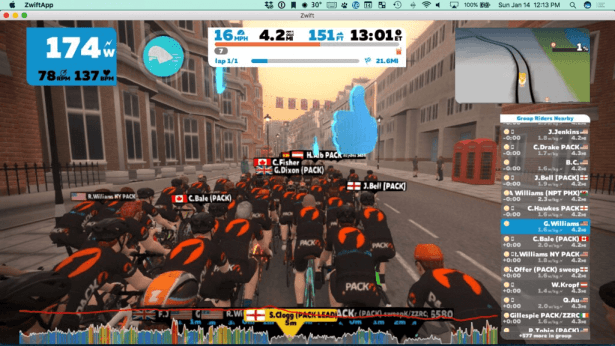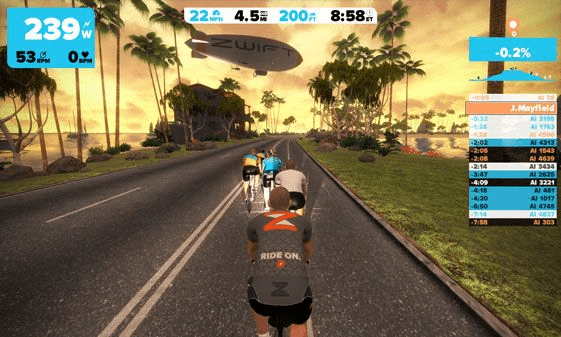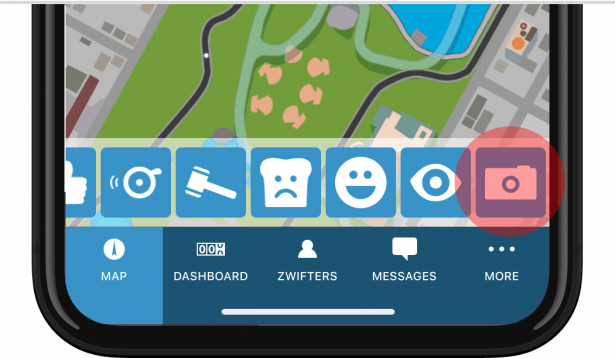Zwift Review
-
Total Rating
Summary
For me, Zwift has changed indoor cycling. I used to find it boring, lonely and uninspiring. Now, it’s an important part of my training routine.
Pros
- Immersive cycling experience and massive global community
- Makes indoor cycling fun
- Loads of worlds and routes to explore
- Over 1000 structured workouts
Cons
- The subscription price can put some people off
- Set up, particularly if using a smart turbo trainer, can be expensive
- The data can sometimes be misleading and/or inaccurate
User Review
( votes)When it comes to virtual cycling, the market leader is Zwift. Let’s face it, most cyclists will jump at the chance to explore the virtual cycling world of Zwift, all from the comfort of their own home – particularly during the winter months when the weather gets worse!
What is Zwift?
Essentially, Zwift is a virtual cycling platform in which a turbo trainer (or a smart turbo trainer for improved performance) is hooked up to the Zwift platform using smart sensors and your cycling avatar replicates your cycling on the turbo trainer, but in a virtual world.
Zwift was originally created as the perfect training aide for winter months when the weather is bad but has become a lot more mainstream as more smart turbo trainers become available and the cycling Zwift community grows.
Smart turbo trainers aren’t cheap, but the difference in using Zwift with a smart turbo trainer compared to a normal one is quite dramatic.
Smart trainers can automatically alter resistance when on inclines and going downhill, so the actual cycling experience feels more ‘real-world’. Obviously, going up a hill then becomes a serious workout.
If you’ve never heard of Zwift but think it sounds interesting, they offer a 7-day free trial (no payment required) so give it a go!
Once you’ve joined the Zwift community and got yourself in the middle of a big virtual peloton, you’ll be hooked.
Plus, you can set yourself specific workouts for a more intense session, distance goals and so on. Personally, I think the workout varieties are one of the best things about Zwift as you can pick the ride you want: A HIIT spin session, a distance ride, a mountain climb, or a more gentle cruise.
Check out the peloton below.

Zwift describes itself as:
“Zwift blends the fun of video games with the intensity of serious training, helping you get faster.”
Level up in the virtual worlds of Zwift with a community that motivates you every minute. Choose from training plans, group rides, races, and more. You’ll get fitter and stronger.’
Simply put, Zwift has revolutionized the face of indoor cycling. But, it’s not alone.
The virtual cycling market
The surge of virtual cycling platforms has been significant, and there are plenty of other options for Zwift. While nothing will beat cycling outdoors, the appetite for virtual cycling and having an intense workout in your own home has been significant.
It’s easy to see why. Virtual cycling provides the same physical and mental health benefits associated with a HIIT session (essentially maximizing the time spent on your bike), all in a fun, competitive environment.
Most platforms offer a variety of different routes and workouts to keep things spiced up. Zwift, for instance, has a load of different maps available to keep you entertained exploring them. Six ‘worlds’, in fact, with 80 available routes.

Today’s virtual cycling market has Zwift challengers popping up all over the place. Bkool, TrainerRoad, Tacx, and Road Grand Tours all offer good alternatives to Zwift.
With the new generation of smarter turbo trainers taking over, especially as indoor cycling becomes more popular, getting started on a virtual cycling platform has never been easier.
What you need to get started
So, I’ve already mentioned that Zwift gamifies virtual cycling, enabling you to meet up with other cyclists around the world in a virtual setting. But, how do you get started?
Basically, there are two approaches. Both of them require you to be able to connect to the Zwift platform. Start by downloading the Zwift app on your mobile or computer.
And, obviously, you need a bike. Most Zwifters use a road bike, with the back wheel attached to the turbo trainer, but mountain bikes, hybrids, and smart bikes also work.
Firstly, Zwift works with a normal indoor turbo trainer. If it is a basic non-smart trainer, you’ll need a few extra bits of kit to get it Zwift ready. An ANT+ cadence and speed sensor are required to connect your bike to the Zwift app.
This sensor is what sends the data generated by you cycling to Zwift, which is required to make your avatar move. An ANT+ sensor is pretty cost-effective, making this set up relatively cheap, assuming you already own a bike.
A basic turbo trainer shouldn’t set you back too much either. Load your bike onto the turbo trainer, connect the app to your sensors (you’ve added to your bike), once they are connected, start pedaling.
Secondly, Zwift is best-used with a more expensive (can be upwards of $1000) smart turbo trainer that can automatically alter the speed and resistance you feel when cycling on certain terrain.
When cycling in Zwift gets harder, the resistance also gets harder. When you’re going downhill, pedaling gets easier.
When you’re drafting, you don’t have to pedal as hard. If you are using a smart turbo trainer with built-in power and cadence sensors, connecting to the Zwift platform is as easy as saying ‘cycle’.
The smart trainer has built-in functionality to connect directly to the Zwift app and automatically start measuring your power and speed. All you need to do is load your bike onto the turbo trainer, open the app and wait for the sensors to connect, and then start pedaling.
Some turbo trainers today are specifically made for indoor cycling and have no back wheel – these are expensive but provide the best indoor cycling experience.
Additionally, you can often find gym bikes who have embraced the Zwift platform and provide specialist Zwift bikes that you can connect your app to so you can map your ride.
Still, confused? Check out Zwift’s get Zwifting guide and its ‘How to: Ride’ section for a load of videos designed to help you get set up. Alternatively, see Zwift’s shop to get everything you need to get pedaling.
With the data generated, Zwift uses it to calculate your speed within the game, taking into account your rider weight, the terrain you are cycling on if you are in a peloton, and so on. It really is a smart, immersive experience that has made indoor cycling so fun.
The paid Zwift subscription costs $12.99 per month, giving you access to all the routes and worlds, training plans, software updates, and so on.
The pros
- Immersive cycling experience and massive global community
- Makes indoor cycling fun
- Loads of worlds and routes to explore
- Over 1000 structured workouts
The cons
- The subscription price can put some people off
- Set up, particularly if using a smart turbo trainer, can be expensive
- The data can sometimes be misleading and/or inaccurate
Rating
5/5 – it’s really hard to find any faults with Zwift. If you like indoor cycling, you’ll love Zwift.
Summarising Zwift
For me, Zwift has changed indoor cycling. I used to find it boring, lonely and uninspiring. Now, it’s an important part of my training routine.
Particularly for short, intense sessions, I love the HIIT workouts. I’m genuinely exhausted after them. Plus, when the weather is bad, it comes in handy to be able to continue cycling rather than go out in the rain.
I love that you can choose really specific workouts and routines based on what you want to improve. If it is speed and power you are looking for, there are loads of workout options specifically designed for building on that.
If you want to become a better climber, again, there are loads of options designed to improve your climbing.
I’ve found that really beneficial to increase my cardiovascular performance, overall endurance, and ability to get up longer, gradual climbs. See Zwift’s training plans here.
Zwift enables all cyclists, of any ability, to participate in group rides. Zwift has done a great job in building an active community so it’s become a social experience as well.
You can even take screenshots of your avatar cycling around if you have the Zwift Companion (ZC) app.
Then you can share it on Strava or on the Zwift community – yes, it does connect to Strava so you can count the miles! Take a screenshot on the app using the button below.

It’s obviously not designed to be a replacement for the real thing. It’d be hard to beat the great outdoors. But as a training aid, it’s the perfect addition.
It’s also worth mentioning that due to the success of the virtual cycling platform, Zwift launched a virtual running world. So you can grab yourself a treadmill and run too!

Founder of Vivi Nation, the cycling, running and active living brand. Chris is a sports enthusiast, occasional triathlete and experienced cyclist, having led multiple cycle tours across Europe.

![Xiaomi Portable Electric Air Compressor 1S Review [Find Out If It’s Worth The Money] Xiaomi Portable Electric Air Compressor 1S Review [Find Out If It’s Worth The Money]](https://biketestreviews.com/wp/wp-content/uploads/2023/07/xiaomi_air-min-500x300.jpg)

Many of my friends use Zwift and love it!bNice review